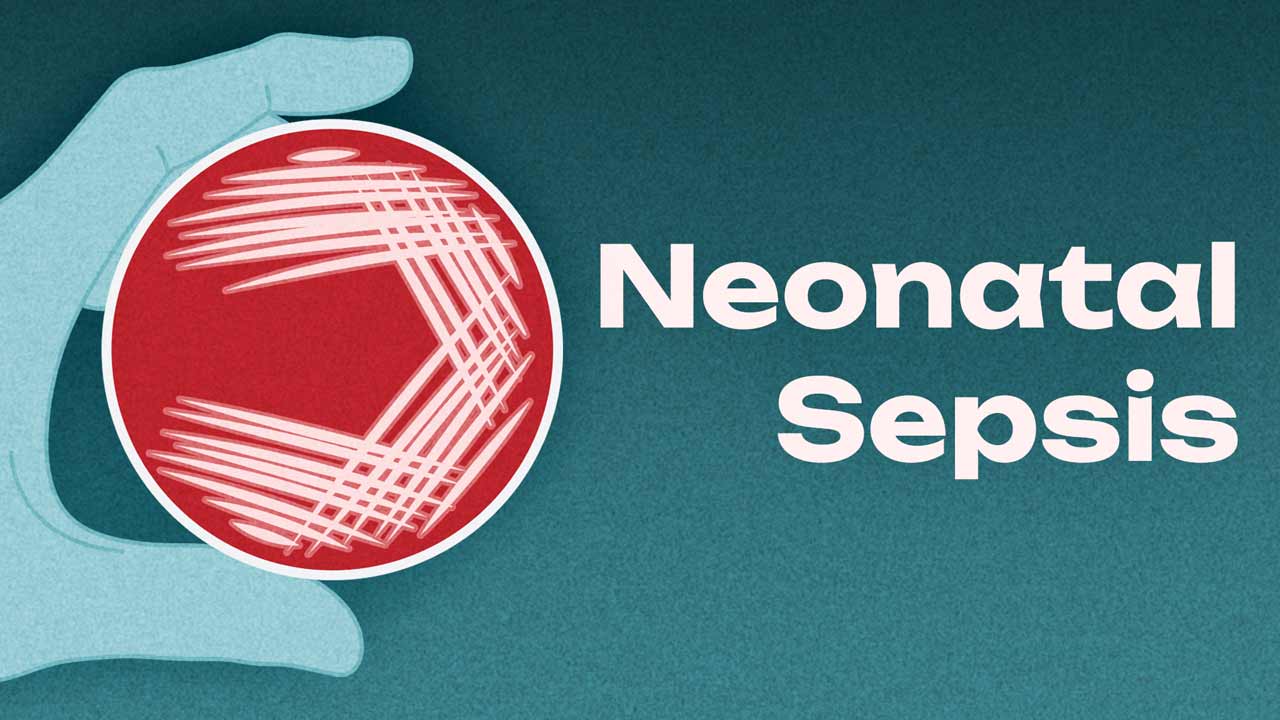Sepsis is a leading cause of mortality in neonates, estimated to occur in one to eight out of every 1,000 births (WHO 2024; SCV 2018).
With a relatively weak and immature immune system, newborn infants less than 28 days old are particularly vulnerable to infection entering the bloodstream and causing sepsis. It’s a condition that not only causes significant morbidity and mortality but one that remains stubbornly difficult to diagnose and treat (Singh et al. 2022).
Defining Neonatal Sepsis
There are two categories of neonatal sepsis based on the time of presentation after birth:
- Early-onset sepsis (EOS) refers to sepsis in neonates within the first 72 hours of life
- Late-onset sepsis (LOS) refers to sepsis that occurs after the first 72 hours of life.
(NICE 2024)
Early-onset Sepsis
EOS is a potentially fatal condition associated with birth canal pathogens that are transmitted in utero or during birth (LaMonica 2024).
Both term and preterm infants with EOS often exhibit respiratory distress, which can rapidly progress to multisystem involvement within the first 24 hours of life (LaMonica 2024).
Late-onset Sepsis
LOS is typically acquired after delivery. Infection is caused by hospital-acquired microorganisms and is seen more commonly in premature and low birth weight babies (LaMonica 2024).

Organisms Commonly Associated With Neonatal Sepsis
Early-onset Sepsis
- Group B streptococcus
- Escherichia coli
- Listeria monocytogenes
- Other streptococci including Streptococcus pyogenes, viridans group streptococci and Streptococcus pneumoniae
- Enterococci
- Haemophilus influenza.
(Singh et al. 2022; LaMonica 2024)
Late-onset Sepsis
- Coagulase-negative staphylococci
- Staphylococcus aureus
- Escherichia coli
- Enterococci
- Klebsiella, Pseudomonas, Enterobacter, Citrobacter, Candida and Serratia species.
(Singh et al. 2022; LaMonica 2024; Santhanam 2024)
Risk Factors for Neonatal Sepsis
General risk factors that may predispose an infant to infection include:
- Preterm labour
- Prolonged rupture of membranes (over 18 hours)
- Maternal fever including chorioamnionitis, maternal septicaemia and transient bacteraemia
- Multiple pregnancy
- Previously infected infant
- Prematurity
- Low birth weight
- Premature rupture of the membranes
- Birth asphyxia (as hypoxia and acidosis may reduce cellular immune functions)
- Coitus occurring close to delivery
- Postnatal procedures such as intubation, chest tube insertion and catheterisation of umbilical vessels
- Foul-smelling amniotic fluid
- Low socioeconomic status
- Maternal malnutrition
- Lack of prenatal care
- Maternal substance abuse
- Maternal urinary tract infection at delivery
- Peripartum infection
- Clinical amnionitis
- Maternal bacterial colonisation.
(Singh et al. 2022; LaMonica 2024)
Specific Risk Factors for Early-Onset Sepsis
- Prolonged rupture of the membranes (longer than 18 hours)
- Fetal distress
- Maternal fever of over 38 °C or maternal infection (e.g. urinary tract infection, gastroenteritis)
- Undergoing several obstetric procedures (including cervical sutures)
- Preterm delivery
- Group B streptococcus (GBS) in previous infants
- GBS bacteria in urine during pregnancy.
(SCV 2018)
Specific Risk Factors for Late-Onset Sepsis
- Male neonate
- Prolonged hospital stay
- Invasive devices in situ (e.g. intravenous catheters, endotracheal tubes)
- Cross-infection from staff and the infant’s parents
- Malformations (e.g. urinary tract anomalies or neural tube defects).
(SCV 2018)
Recognition of Systemic Neonatal Sepsis
Rapid recognition of sepsis is crucial, as if left untreated it can lead to serious consequences (SCV 2018).
However, while it is important to identify even subtle signs, avoid over-diagnosing. In most cases, an infant with a fever does not have sepsis (RCHM 2020).
Note that the signs of neonatal sepsis may appear non-specific, as they are clinically similar to the symptoms of other conditions such as cardiac or respiratory failure and metabolic disorders (SCV 2018).
Look out for:
| General signs |
|
| Respiratory signs |
|
| Cardiovascular signs |
|
| Cutaneous signs |
|
| Gastrointestinal signs |
|
| Central nervous system signs |
|
(SCV 2018)
Swift and Skilful Management is Essential
Singh et al. (2022) suggest that although specific treatment regimes for neonatal sepsis differ based on various risk factors, empiric treatment with antibiotics should generally be started as soon as sepsis is clinically suspected, even before confirmatory laboratory data becomes available. With mortality rates that are inversely proportional to gestational age, preterm infants are particularly vulnerable and often suffer impaired neurodevelopment or vision impairment.

To date, no effective treatments exist for sepsis beyond antimicrobials and supportive care. With no guaranteed means of early recognition or diagnosis, antibiotics tend to be given as soon as a case of early-onset sepsis is suspected.
Delaying treatment can have devastating consequences, yet the early and accurate diagnosis of sepsis is difficult and often has limited accuracy. It’s only as time progresses and laboratory results become available that the management of this challenging condition can be refined.
Investigations for Neonatal Sepsis
| General tests |
|
| Infection-related tests |
|
| Tests to identify the infective organism |
|
(SCV 2018)
Conclusion
Today, sepsis remains a significant contributor to morbidity and mortality in neonates (Singh et al. 2022).
It’s possible that future research will help identify clear early warning signs that can lead to a formal diagnosis, but for now, many challenges remain in both the diagnosis and management of sepsis in the neonate.
Test Your Knowledge
Question 1 of 3
True or false: Male neonates are at higher risk of late-onset sepsis.
Topics
Further your knowledge
References
- Safer Care Victoria 2018, Sepsis in Neonates, Victoria State Government, viewed 10 January 2025, https://www.bettersafercare.vic.gov.au/clinical-guidance/neonatal/sepsis-in-neonates
- LaMonica, K 2024, Neonatal Infections, CEUfast, viewed 10 January 2025, https://ceufast.com/course/neonatal-infections-2020
- National Institute for Health and Care Excellence 2024, Neonatal Infection: Antibiotics for Prevention and Treatment, NICE, viewed 10 January 2025, https://www.nice.org.uk/guidance/ng195/
- The Royal Children's Hospital Melbourne 2020, Sepsis – Assessment and Management, RCHM, viewed 10 January 2025, https://www.rch.org.au/clinicalguide/guideline_index/SEPSIS_assessment_and_management/
- Rozensztrauch, A, Terpiłowska, M, Małgorzata Trebenda, T, Tułacz, K & Berghausen-Mazur, M 2018, 'Sepsis in the Neonate – Nurses’ Knowledge', Archives of Nursing and Care, vol. 1, no. 3, viewed 10 January 2025, https://www.openaccessjournals.com/articles/sepsis-in-the-neonate--nurses-knowledge.pdf
- Santhanam, S 2024, Pediatric Sepsis, Medscape, viewed 10 January 2025, https://emedicine.medscape.com/article/972559-overview
- Singh, M, Alsaleem, M & Gray, C P 2022, 'Neonatal Sepsis', StatPearls, viewed 10 January 2025, https://www.ncbi.nlm.nih.gov/books/NBK531478/
- World Health Organisation 2024, Sepsis, WHO, viewed 9 January 2025, https://www.who.int/news-room/fact-sheets/detail/sepsis
 New
New 

